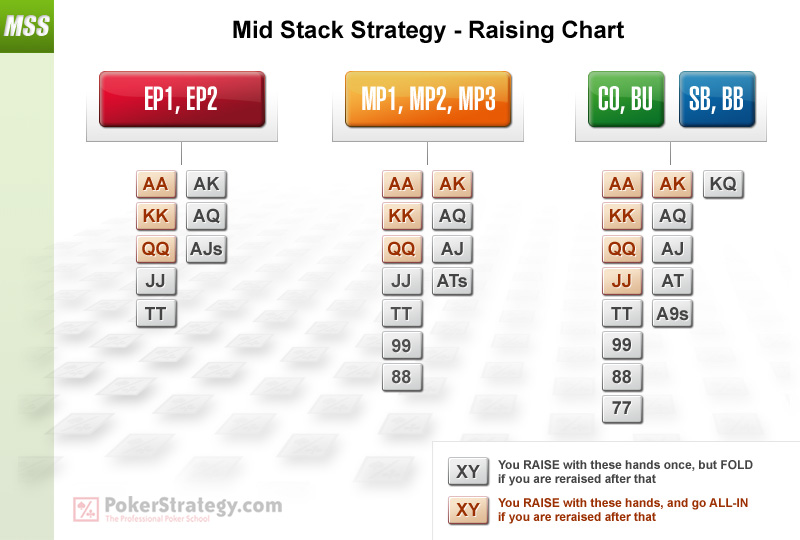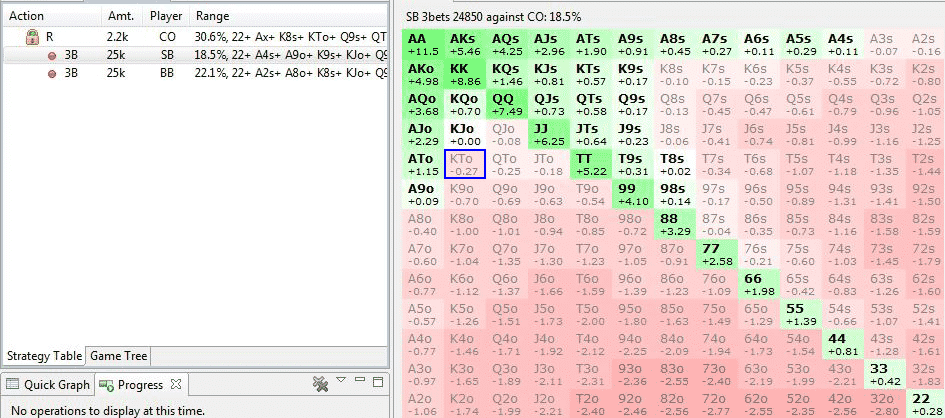Short Stack Poker Chart
For a guide to beating short stack poker players, check out the 'Crushing Shortstackers' concept video.
- Your 100BB instantly becomes a 50BB stack. A 25BB stack becomes a very short 12.5BB stacks vs. That straddle, and even with 100BB, you are effectively playing short-stacked poker. Short-stacked strategy goes hand-in-hand with SPR.
- See full list on paulphuapoker.com.

Learn your preflop ranges. Every decision you make while short stacked preflop is worth a big chunk. Go to Poker School; Find a Poker Coach; Reliable Rakeback; Play Poker For Real Money Welcome! Welcome to Push Fold Charts, where you can play mistake-free poker with a short stack. Be sure to check out our new product page, featuring the entire Full Ring Game Chart on a pocket-sized glossy card that you can take to the cardroom with you.
There are always going to be times in your poker career where you will find yourself as the short stack at the table and probably having a smaller stack than the rest of your opponents.
It may be because you are in the middle of a tournament and had a bad run of cards, or because you simply enjoy to buy in to cash games with a short stack.
But for whatever reason you are playing with a relatively small amount of chips, it is good to be able to understand and employ a good short stack strategy.
What is a short stack in no limit Texas Hold'em?
The typical short stack in any cash game or tournament will have 40 Big Blinds or less.
However, there are varying degrees of short stack poker as a 10BB stack will require a slightly different strategy than a 40BB stack, and it is important to be aware of these differences.
You may have noticed that the term ‘short stack’ is determined by the size of your stack relative to the blinds, and not relative to the stack sizes of your opponents. Therefore even if you have 30BB and your opponents have 20BB, you are still considered to have a short stack, and so you should continue to utilize a good short stack strategy.
How to play with a short stack.
Having a short stack means that you have less room to make plays at the poker table. Bluffs and advanced moves (like float plays) are formed from being able to make educated checks, bets, calls and raises on each round of the hand, so having a short stack will reduce and sometimes eliminate any room for special manoeuvres by both you and your opponents.

Furthermore, the general structure of a no limit Texas Holdem game is that the bigger bets will be made on the turn and river, as the preflop and flop rounds are usually set-up rounds that build the pot and prepare the hand for action. The fact that we have a short stack means that we will rarely be making it past the flop in terms of betting as we will not having enough chips to continue.
With a short stack, most (or all) of the action will be taking place on the preflop and flop betting rounds.
Hands to play when short-stacked.
The fact that we have little room for movement and that our betting will cease at the flop means that we should be playing big heavy hitting hands that will make strong hands at the flop, rather than smaller hands that have ‘potential’.
We should avoid hands like suited connectors and small pocket pairs, as these hands are profitable when we have a deep stack, as our implied odds are there to compensate for the likely event that we miss the flop. In general we are best entering pots with are big suited cards that can make top pair or better at the flop, although we should exercise some flexibility in starting hand selection depending on the size of our short stack.
Below is a table of the hands we should be looking to play depending on our situation:
Starting hands chart.
Note: This starting hands chart is designed for tournament games where you are pressured to make more moves as the amount of chips left in your stack decreases. This table is not designed for short stack cash game strategy where you have the option of reloading again and again.
40BB or less.
- AA
- KK
- AKs
- AQs
- JJ
- AK
- AQ
- AJs
30BB or less.
- AJ
- TT
- ATs
- KQs


20BB or less.
- AT
- KQ
- KJs
- KJ
10BB or less.
- AXs
- AX
- QJs
- QJ
As you can see, a lot of emphasis has been placed playing big cards that can make top pair or better, which will often be the best hand on the flop. As you should remember it is unlikely that we will make any more bets past the flop betting round, so we should be more than happy to be making a good pair and get our money in on the flop.
You may notice that hands that include aces have been given a lot of weight, especially if you are a very short stack. This is because of the fact that as a extremely short stack, it is more than likely that you will be pushing or calling an all in on the flop regardless if you have caught a piece of it or not. Therefore if we are holding an ace, we will have a better chance of winning with a high card against an opponent in the event that they did not make a pair either.
How to play these hands.
When we are dealt any of the above cards that are within our range depending on the effective stack sizes, we should always be raising when entering the pot. It may seem like a good idea to limp and try and catch a good flop for cheap, but it is more profitable to raise and build the pot for when we hit our hand, which we are more likely to do if we are holding a strong starting hand.
With a stack of 10BB or more we should be looking to raise around 3 or 4BB if we are first to enter the pot. However, if we have 10BB or less, it will not be too bad of a play to push all-in straight away, as any call from a 4BB raise will leave us completely pot-committed anyway. With 10BB or less, you can think about using the stop and go play also.
On the flop we are usually reduced to going all-in or folding as a short stack. The smaller the size of our stack, the more inclined we should be to calling or pushing all-in as we are more likely to be committed to the pot. The shorter the stack, the less the flop will matter to us. However, if we have around 30/40BB, we can be a little more selective because we will not be pot committed and have the opportunity to wait for a better spot.
The shorter your stack, the less post-flop action you are going to deal with. So it's important to have a strong hand that has a good chance of winning after all 5 community cards have been dealt.
Nevertheless, if we are pot committed and will be moving all-in regardless, it is always better to make the all-in bet rather than calling if possible. This is because by betting we are giving our opponent the opportunity to fold the best hand or a potentially winning hand, which is something that is not available to us if we are calling the all-in bet.
- Short stack tips overview.
- Play simple ABC poker. Avoid attempting to bluff and just bet when you have a strong hand.
- Only enter pots with premium hands.
- Fold small pocket pairs and suited connectors as you have do not have implied odds.
- Make strong 4BB raises before the flop.
- Be prepared to move all of your stack in to the middle before or on the flop.
- Leave the table if you win a big pot (and intend on playing short-stacked).
Short stack strategy evaluation.
Good short stack strategy is all about pushing every little edge that we have. Just because we have a smaller stack, it does not mean that we have less chance of winning any individual hand, it just means we have to adapt our play a little differently to each situation.
Nevertheless, we will be facing an up hill battle if we are in a tournament as each pot we enter is more likely to involve putting our tournament life on the line. At some poker sites, the structure of the faster tournaments will mean that you will spend the majority of the game as a short stack, which is a good way to learn how to play good short stack poker.
We should always look for the most profitable situations and get our money in when we think we have the best of it, and we should always prepare for luck to play its part in each outcome. Playing a good, sound short stack strategy does not guarantee to save a tournament life or secure a double up, but it will improve your chances of coming out on top in the long run.
In cash games, you cannot expect to win every all-in, but you can still play a profitable game by picking the right situations and trying to get your money in with the best hand.
Go back to the awesome Texas Hold'em Strategy.
Comments
This week CardRunners coach Samer 'Braminc' Khuri explains ICM calculators and how fully understanding them can help us with super short-stack poker tournament strategy.
Samer 'Braminc' Khuri has been playing SNGs full time since 2006. He plays a wide range of stakes and his latest CardRunners video series, SNG Payout Analysis, explains how to effectively adjust to any tournament structure in the world. In his spare time he plays guitar, sings, and writes music.
Take it away Samer.
Most people that play poker tournaments are familiar with one very basic and crucial concept: When your stack reaches a certain critically low level, you must either go all-in or fold pre-flop.
Raising a standard amount becomes suboptimal, as you will end up having less fold equity yet still be committed to the pot after the flop (no matter what the flop is).
The idea is to maximize our fold equity while we have it to increase our chances of survival.
What Exactly is 'Critically Low' in Poker?
While this is widely accepted, there is some debate as to just how short stacked “critically low” is. Some players seem to only shove/fold when their stack reaches 15 big blinds or less. Some say 10 big blinds or less.
Some point out that you should calculate your M—your stack size divided by the total value of the blinds and antes—and shove whenever M is less than 10. None of these answers is exactly right or wrong. It depends on the tendencies of your opponents, how they view a pre-flop shove from you, and how they react to a standard raise from you.
10 big blinds and an M of 10 have always been key values for me. There are absolutely times when I will shove 15 or even 20 big blinds, and there are other times when I will make a standard raise with as few as 8 big blinds. Both of those scenarios are rare, and they are not what this article is about.
Short Stack Poker Chart Printable
I want to discuss the shortest of short stacks: the times you have 5 big blinds or less (or an M of 5 or less). In these situations, you are running out of fold equity. You need to move quickly. To play cautiously at this stage will lose you money in the long run.
Many of us use ICM calculators to determine what hands are +EV to shove in what spots (and what hands aren’t). These ICM calculators are the key to short stack tournament poker. However, they have limitations.
What is ICM?
ICM is a measurement of total prize pool equity. Using it, you can compare the value of your stack if you move in and if you fold.
The first problem we encounter is that your prize pool equity is based solely on the number of chips you have now relative to the total number of chips and players remaining. No account is taken of the players’ skill.
The calculator doesn’t know how good you are; even we humans don’t know exactly how good anyone is. So, if you are one of the best players at the table, ICM is likely to underestimate the value of your stack; this will affect the best play sometimes.
Another major limitation of ICM, and the most relevant one to this article, is that because these calculators simply compare your prize pool equity if you shove or fold immediately after the hand, they ignore future hands.
Another way to put this point is that the real value of your stack can depend on the position of the blinds, whether you are likely to be in very bad situations soon, and so on.
Take Shoves That Are -EV
In my view, when you are as short as 4 or 5 big blinds, you need to take shoves that ICM says are –EV, because folding is often even worse than ICM indicates.
The problem is that calculating just how bad our future situations will be can be extremely difficult. Nobody can figure this out with complete accuracy; it depends on all our opponents’ tendencies and is sensitive to very small changes in their stack sizes.
Usually we will not be dealt monster cards within the next orbit of play, and since our fold equity will disappear when we continue folding, we will be getting our chips all-in as huge underdogs a majority of the time.
After studying hundreds of short-stack tournament scenarios, I can confidently say that the degree to which we should be willing to take -EV shoves at 4-5 big blinds is much higher than I ever would have expected.
Short Stack Poker
In a typical SNG, -1% to -2% of the prize pool is an extremely reasonable -EV shove to make under the gun when facing the alternative of blinding out of play. In larger tournaments the same is true, although the exact number will be different because of the greater field size.
If you are able to fully understand what ICM is, how it works, and what the ICM calculators are telling you, then you can apply good reasoning to learn when it is appropriate to deviate from their suggestions.
The Tournament Must Continue
In this case, we have observed that ICM calculators are unaware that the tournament doesn’t end after the exact hand it is analyzing.
Because the tournament must continue, folding trashy cards with a stack of 4 or 5 big blinds can be pure suicide as you will soon have literally zero fold equity and close to zero prize pool equity.
We must do our best to estimate which -EV shoves are appropriate and which aren’t. The short answer is that almost all -EV shoves in the described situation are very appropriate and necessary.
Improve your poker game with CardRunners. CardRunners offers all the tools you need to learn poker, including new videos released daily, strategy forums, pro interviews and more.
Short Stack Poker Strategy
Read More PokerListings/Cardrunners Strategy Articles:
- Key Differences Between US and Euro Online Poker Sites
Poker Hands Chart
Samer 'Braminc' Khuri has been playing SNGs full time since 2006. He plays a wide range of stakes and his latest CardRunners video series, SNG Payout Analysis, explains how to effectively adjust to any tournament structure in the world. In his spare time he plays guitar, sings, and writes music.